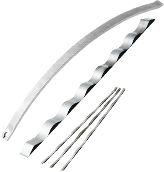Question Spring Newbie 2009/7/15(Wed) 22:32
In JIS B 2704, “8.1. Spring that receives static load: The torsional stress of the spring that receives static load is calculated by equation (3). 8.2. Spring that receives repetitive load: The stress of the spring that receives repetitive load is calculated by equation (5).
Why do we consider torsional stress for springs receiving static load whilst considering corrected torsional stress for springs receiving repetitive load? I think both must be considered in terms of corrected torsional stress.
Why does JIS say that only torsional stress needed to be considered for springs receiving static load?
Answer Tokai Spring 2009/7/16(Thu) 0:25
Thank you for writing to us!
For torsional stress, the average stress applied to the center diameter of the coil is shown. Regarding the corrected torsional stress, the maximum stress on the inner diameter side of the coil with the largest load is shown.
In addition, since there is concern about fatigue failure in dynamic use, the maximum stress applied to the spring (corrected torsional stress) is used for evaluation. On the other hand, if a spring is set to used with static load, it can be used if the average stress (torsional stress) applied to the spring is 80% or less of Fig. 5 (allowable torsional stress) described in JIS.
A torsional stress of 1070MPaX80% = 856MPa or less is OK!
Answer Spring Newbie 2009/7/16(Thu) 22:46
I’m sorry, but I don’t quite understand. Even with a static load, the stress is actually the highest on the inner diameter side, so even with a static load, if you do not consider the corrected torsional stress, it may be damaged from the inner diameter side. I’m sorry for not understanding, but please help me understand.
Answer Tokai Spring 2009/7/17(Fri) 14:37
Regarding damage, dynamic fatigue fracture is the main factor, and in static use, if it is used in excess of the allowable stress, some degree of permanent deformation (sagging) will occur. Please be assured that the allowable torsional stress is a standard value calculated by multiplying the tensile strength of the material by the specified coefficient, and it does not mean that damage will occur immediately unless the corrected stress is applied!
We are happy to answer any inquiries regarding technology, specifications, materials, etc. Please feel free to ask.

















